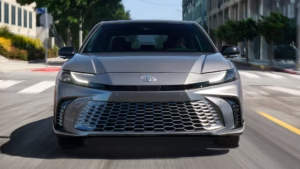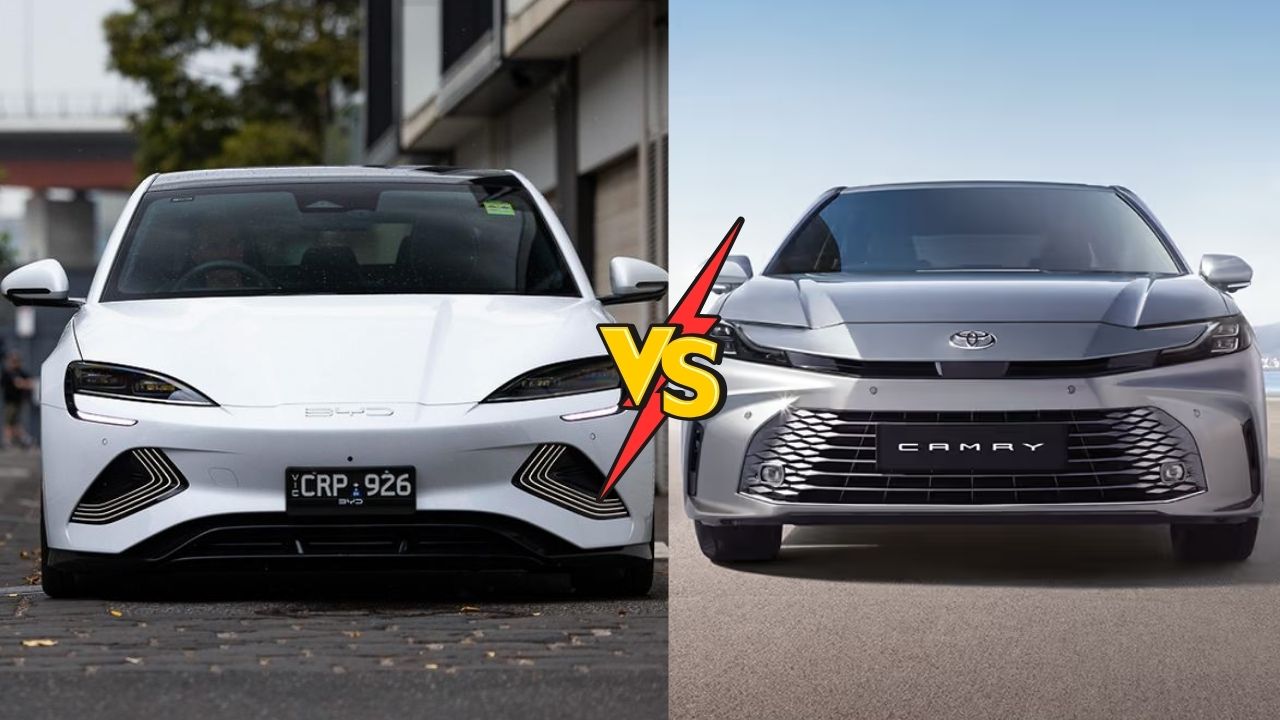Australian car buyers might soon have a game-changing alternative to the popular Toyota Camry Hybrid. Chinese automotive giant BYD has quietly secured trademark protection for two mysterious model names – “King” and “King L” – signalling their intention to launch a plug-in hybrid sedan that directly targets Toyota’s bestselling family car.
The move represents BYD’s boldest step yet into Australia’s traditional sedan market. While most manufacturers abandon sedans for SUVs, BYD sees an opportunity to capture the hearts of taxi drivers, rideshare operators, and efficiency-minded families who still prefer four-door comfort.
What Makes the BYD King Special?
BYD’s King sedan is expected to be the international version of China’s BYD Qin model. This isn’t just another electric car trying to win over skeptical buyers. Instead, it’s a sophisticated plug-in hybrid that bridges the gap between traditional petrol engines and full electric driving.
The King uses BYD’s DM-i technology, which stands for Dual Motor Intelligence. This system combines a 1.5-litre turbo petrol engine producing 81kW and 135Nm with a powerful 132kW electric motor that delivers 316Nm of instant torque. Together, they create a smooth, efficient driving experience that could make Camry owners think twice.
What sets this apart from Toyota’s hybrid system? The King offers genuine plug-in capability with around 55 kilometres of pure electric range. This means most daily commutes happen in complete silence, with zero emissions and minimal running costs.

The Technology Behind the King’s Crown
BYD’s DM-i system represents years of battery expertise translated into automotive excellence. The company started as a battery manufacturer in 1995 before entering the car business, giving them unique insights into energy storage and management.
The King’s 8.32kWh Blade Battery enables that crucial electric-only range. BYD’s Blade Battery technology has proven itself across their global model range, offering improved safety and longevity compared to traditional lithium-ion setups. Australian buyers get the peace of mind that comes with BYD’s proven battery chemistry.
Charging happens multiple ways with the King sedan. Owners can plug in at home overnight, top up at work, or use public charging infrastructure. The system seamlessly switches between electric and hybrid modes, ensuring you’re never stranded.
How Does It Stack Against the Camry?
Toyota’s 2025 Camry Hybrid has raised the bar significantly. The latest model delivers 170kW of combined power and achieves 4.0L/100km fuel consumption. It’s a formidable opponent that has dominated Australian roads for decades.
BYD’s King counters with different strengths. While the Camry excels at consistent hybrid efficiency, the King offers electric-first driving. Those 55 electric kilometres mean many drivers could go days without using petrol. When the engine does engage, fuel consumption drops to just 1.29L/100km in electric-equivalent terms.
Size and space should be comparable between both sedans. The King measures similarly to mid-size family cars, offering practical 450-litre boot space and comfortable seating for five adults. Australian families won’t need to compromise on practicality.
Pricing: The Real Game Changer
BYD has consistently undercut established brands since arriving in Australia. Their Atto 3 electric SUV launched thousands below comparable rivals, while the Seal sedan challenged Tesla’s Model 3 on price and features.
If BYD follows this strategy, the King could arrive significantly cheaper than the Camry’s $39,990 starting price. Industry insiders suggest BYD might target the low-to-mid $30,000 range, making advanced plug-in hybrid technology accessible to more Australian buyers.
This pricing approach has proven successful across BYD’s global markets. By offering more technology for less money, they’ve rapidly gained market share in countries where established brands previously dominated.
Australian Market Timing
BYD’s trademark applications suggest serious intent, but timing remains uncertain. The company has committed to launching two new models annually through 2025, with sedans specifically mentioned as a priority category.
Australian preferences are shifting towards electrification, but many buyers still hesitate over pure electric vehicles. Plug-in hybrids like the King offer the perfect compromise – electric driving for daily use, with petrol backup for longer journeys.
Government incentives in several states support plug-in hybrid purchases through stamp duty exemptions and registration discounts. These benefits could make the King even more attractive compared to traditional petrol alternatives.
The Ride Share Revolution
Taxi and rideshare operators represent a crucial market segment for both Toyota and BYD. The Camry dominates this space due to its reliability, fuel efficiency, and passenger comfort.
BYD’s King could disrupt this established order. With electric-only operation in city centres, rideshare drivers could dramatically reduce fuel costs while meeting emerging zero-emission zone requirements. The quiet electric driving also enhances passenger comfort.
Commercial buyers typically focus on total cost of ownership rather than purchase price alone. The King’s plug-in capability means operators could slash running costs, potentially justifying any price premium over conventional hybrids.
Challenges and Opportunities
BYD faces significant challenges breaking into Australia’s conservative sedan market. Toyota’s reputation for reliability and resale value has been built over decades. Many buyers will need convincing that Chinese quality matches Japanese standards.
Service network coverage represents another hurdle. Toyota dealers blanket the continent, while BYD is still expanding their presence beyond major cities. Rural buyers particularly value local service support.
However, opportunities abound for a well-executed challenger. Australian sedan buyers have limited choices as manufacturers abandon the segment. The King could capture frustrated customers seeking modern technology and efficiency.
Environmental Impact
Climate-conscious buyers increasingly consider environmental credentials alongside traditional factors. The King’s electric capability allows zero-emission driving for most daily use, significantly reducing urban air pollution.
BYD’s battery expertise enables more sustainable manufacturing compared to companies sourcing batteries externally. Their Blade Battery chemistry uses less cobalt than traditional designs, addressing ethical mining concerns.
Lifecycle emissions from plug-in hybrids depend heavily on electricity sources. Australia’s growing renewable energy sector means charging increasingly comes from clean sources, enhancing the environmental benefits.
Technology and Features
Modern Australian buyers expect comprehensive technology integration. The King sedan should offer wireless smartphone connectivity, advanced driver assistance, and over-the-air updates that keep software current.
BYD’s latest models feature rotating touchscreen displays, premium audio systems, and sophisticated climate control. Australian-spec versions typically include Android Auto and Apple CarPlay for seamless smartphone integration.
Safety technology must meet local expectations to succeed. BYD’s newer models score well in international testing, with comprehensive airbag systems, autonomous emergency braking, and lane-keeping assistance.
The Competition Landscape
Beyond Toyota’s Camry, the King faces competition from an evolving sedan market. Tesla’s Model 3 dominates premium electric sedans, while BYD’s own Seal targets similar buyers with pure electric power.
Traditional manufacturers like Mazda still offer petrol sedans, but most have abandoned or scaled back sedan development. This creates opportunity for BYD to capture displaced customers seeking modern alternatives.
Plug-in hybrid sedans remain rare in Australia, giving the King potential first-mover advantage in this specific niche. Success could encourage other manufacturers to reconsider sedan strategies.
What This Means for Australian Buyers
Competition benefits consumers through better value, more choice, and innovative technology. The King’s potential arrival could pressure Toyota to enhance Camry features or adjust pricing.
Early adopters might benefit from launch incentives that BYD typically offers new models. However, waiting allows competitors time to respond and early issues to be resolved.
The broader impact extends beyond individual purchases. Successful challenger brands encourage innovation across the industry, ultimately delivering better vehicles for all buyers.
Frequently Asked Questions
Q: When will the BYD King launch in Australia? BYD hasn’t announced official timing, but trademark applications suggest a 2025 or 2026 launch timeframe.
Q: How much will the BYD King cost compared to the Toyota Camry? While unconfirmed, expect pricing significantly below the Camry’s $39,990 starting price, potentially in the low-to-mid $30,000 range.
Q: What’s the difference between the King and King L variants? The King L likely offers additional features, larger dimensions, or extended electric range compared to the standard King model.
